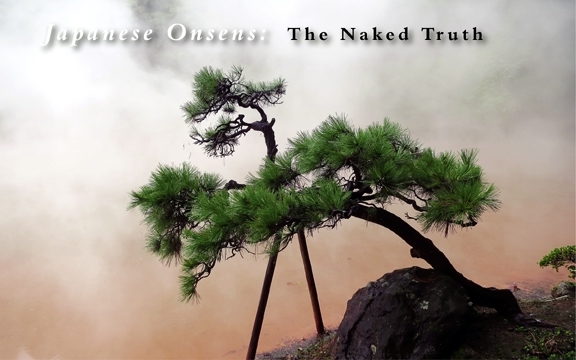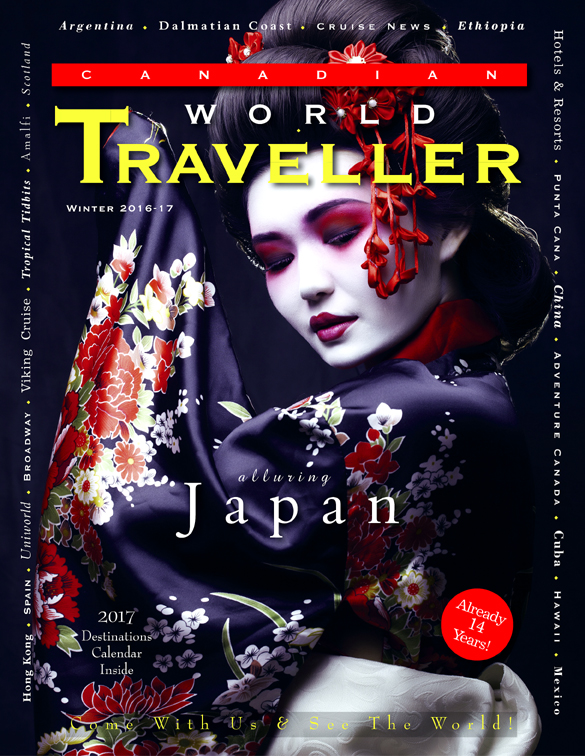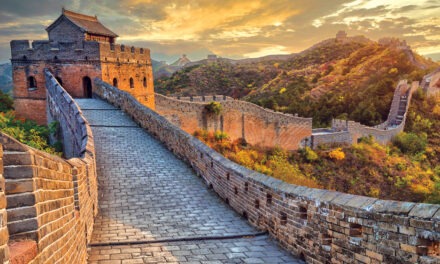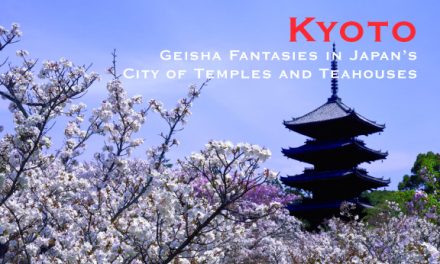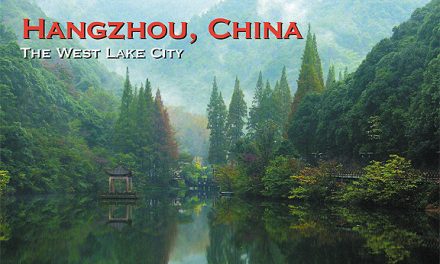Japan
Japanese Onsens: The Naked Truth
Article & Photography by Jennifer Merrick

I normally jump, well maybe not jump in the skydiving or bungee sense, but certainly embrace opportunities to try new experiences. Edgewalk outside the CN Tower? Sure. Munch on Chapulines, fried grasshoppers, in Mexico? Why not?
But what I’m contemplating now is lightyears beyond my comfort zone, and it doesn’t even require signing a waiver. Should I try an onsen, a Japanese hot spring used for bathing? The thought of soaking in the thermal, mineral-infused waters is oh-so-appealing after a long day of travelling. But there’s one caveat –no bathing suits allowed. I would have to go in naked, a daunting prospect for a middle-aged, North American woman who has never so much as gone topless on a beach.
I’m in Kyushu, the southernmost of Japan’s main islands, known for its subtropical climate, beaches, rich history and natural beauty. But in the northern part of this island, which has one of the largest concentrations of hot springs in the world, many visitors come specifically for their onsens. When we arrive at Oita airport, a two-hour flight from Tokyo, there’s a large display depicting a smiling cartoon wooden tub to greet us. Gift shops are filled with mineral bath powders and bathing towels, one of which has an image of an elegant kimono-clad woman, but advertises that when the towel gets wet, the kimono disappears. Besides a tourist attraction, public bathhouses are also very much part of the culture.
“Onsens are very close to our daily life,” says Eiko Umedo, a Japanese native who encourages everyone to take the plunge. “Our family used to go often when I was a child,” she says, and explains that the Japanese use it for relaxation and even healing. “It’s very good for the skin, too,” she adds.
Mmmm, could onsens be the reason for Japanese women’s ageless appearance?
OK, I’ll do it. Gulp.
I put on the cotton robe called a ‘yukata’ and the slippers the Hotel Resol Hakata provides, and make my way downstairs, wishing I’d had more sake with my dinner. The entrance to the baths looks like any change room, except that instead of putting on a bathing suit, you leave all of your outerwear, and take only a key and the so-called ‘modesty towel’. This is very much a misnomer as it’s smaller than a tea towel, but nevertheless I’m grateful for it.
The next step is the cleaning station, which unlike western facilities are not showers, but small stools in front of a sink with buckets and soap. Instructional drawings illustrate the thoroughness expected. I do my best, quickly glancing around to ensure that I was following proper protocol, but trying not to look at any’body’ either.
Now for the onsen itself. There are both indoor and outdoor pools, and though the indoor ones are closer, the darkness of the outdoor pool looks infinitely more enticing. Clutching my towel, and without looking up, I quickly make my way outside. I let out a small sigh when I’m immersed in the dark, warm waters. Tension dissipates as I soak, enjoying the moonlight (not a full moon thankfully), the small waterfall, the rose petals that float on the shimmering water and most of the steaming water that covers my entire body.
This feeling of glorious relaxation lasts for all of 10 minutes, when it starts to become unbearably hot.
Now I’ll have to get out……
A “Hell Tour” of Heavenly Sights
In Northern Kyushu not all hot springs are for soaking in as we find out on the ‘Hell Tour of Beppu’. The city of Beppu calls itself the ‘Hot Springs Capital of Japan,’ and has been showing off its thermal pools, ‘Jigokus’ (hells), to visitors for over 100 years, when Kuma Hachi, a tourism pioneer, developed this excursion to showcase the best of Beppu’s over 2000 hot springs. In fact, it’s considered to be the beginning of the Japanese bus tour as we know it today, complete with the obligatory flag on a stick.
Blood Hell Pond, ‘Chinoike Jigoku’ (some signs refer to it as the Bloody Hell Tour, which especially amuses the British participants on the tour) is our first stop. It’s immediately clear how it got its name. Not only is the water a deep red colour from the mineral-rich clay, but the steam has a pinkish hue, creating a wondrous, atmospheric sight. At near boiling temperatures, there’s no chance of bathing, but you can buy the magnesium-rich clay for your bath or even an ointment, reportedly beneficial for skin conditions.
Sea Hell ‘Umi-Jigoku’ is next and the aqua-marine water mesmerizes us. Walking among the lush gardens while gazing at the blue water surrounded by steam, there’s a sense of serenity, which feels heavenly at this particular hell.
Other hells on the tour include: Shaven Head Hell ‘ Oniishibozu Jigoku’, named for the gray mud that bubbles to the surface resembling the shaven heads of monks, Mountain Hell, ‘Yama Jigoku’, which has a mini zoo, and White Pond Hell, ‘Shirake Jigoku’, that has a chalky white appearance. At Cooking Pot Hell ‘Kamado Jigoku’, you can enjoy boiled eggs cooked in the water of the hot spring. Crocodiles, and lots of them, are the stars of Demon Mountain Hell, ‘Oniyama Jigoku’, and finally there’s Waterspout Hell ‘Tatsumaki Jigoku’, which is a geyser that erupts approximately every 30 minutes, reaching over 50 metres in height.
Steam is everywhere on the Hell Tour, not only at the sites, but emanating from the ryokans (traditional inns) and even individual homes, many of which in Beppu have access to their own underground source of water.
Whether you admire the beauty of these natural wonders, bathe in them or both, the steamy waters that bubble up from the earth in Northern Kyushu offer an unforgettable Japanese adventure for travelers willing to go beyond the Tokyo-Kyoto-Osaka tourist route and, perhaps, beyond their comfort zone.
Activities worth getting out of the onsen for in Northern Kyushu
As impressive as they are, the thermal pools with their ubiquitous steam are not the only attractions worth seeing. Northern Kyushu is a region just waiting to be discovered, with mystic mountain shrines, a buzzing urban scene, and strong culinary traditions. Here are a few activities worth getting out of the onsen for:
Historic Kitsuki
Savour a meal with a 300-year history at Waekaeya Restaurant in the castle town of Kitsuki. Their signature dish is Ureshino, so named because when a feudal lord tasted it, he declared ‘Ureshi-no’, which translates to “I’m happy”.
We’re happy, too, when we taste this traditional ‘Taichazuke’ consisting of sea-bream fish sliced into thin strips over rice and a sesame sauce. At the table, hot green tea is poured on the rice, and we’re told to wait exactly three seconds – no more or less – before lifting the lid and digging in.
Afterwards, explore Kitsuki, where you’ll find preserved Samurai residences and merchant houses from the Edo period. Slope of the Vinegar Maker ‘Suya-no-sake’ and Slope of the Salt Maker ‘ Shioya-no-sake’ are narrow pedestrian paths that rise up to the castle. Climb them to the top for a panoramic view of Beppu Bay.
Hip Fukuoka
Sing karaoke in Fukuoka, the biggest city on the island and a vibrant hub that embraces both its historic roots and modern lifestyle. Its downtown core comes to life at night, when trendy youth take to the streets to enjoy its clubs and karaoke lounges. Don’t worry about embarrassing yourself; as in most of Asian, singing is done in private rooms, and you’re charged a reasonable hourly rate that includes unlimited alcoholic or soft drinks depending on the package.
This flourishing city is home to numerous museums, art galleries, shrines and some of the best shopping in Japan, most notable Canal City. This sprawling, red architectural, shopping centre is referred to as ‘a city within a city’ and comprises of hundreds of shops, restaurants, entertainment complexes and even has its own systems of waterways, hence the name. When you’re shopped out or gotten lost too many times, wander down by the river and sample street food at one of the yatais (food stalls), an ideal spot to people watch and enjoy the city lights.
Spiritual Mountains
Let your spirit soar at the Hikosan Jingu Shrine, where you venture high into the mountains via funicular (or if you’re feeling adventurous, by climbing 3 km of stairs) to this religious site first built in 740. This venerable shrine has been a training ground for Buddhist monks throughout the centuries, and wandering around its temples and buildings, surrounded by mountain mist and tall pine trees, it’s easy to understand why this site is believed to have mystical powers. There’s a sense of communion with nature, which explains perhaps why this religious site was one of the first to combine the Shinto religion, which worships nature, and Buddhism.
Another mountain adventure, this time for your palate, can be found at the enchanting Ohara Chaya Restaurant, located in the middle of forest outside of Hita City.
“Sorry my pants are ripped,” the chef tells us through a translator, “but I was in the mountains picking the food this morning.” There’s no reason to apologize as this is truly an exquisite meal, with local delicacies beautifully presented in a picnic basket. The chef aims for a balance of tastes –bitter, sweet, salty and sour– and each morsel is different. Eating it is like discovering jewels in a treasure box, never knowing exactly what you’ll be getting, but each time delighted. Some of the tapa-like dishes include eggs boiled in the hot springs, sticky sweet potatoes, tofu in plum sauce, egg plants miso and tempera chef-foraged wild grasses.
Living Lunch
Dare to eat the freshest seafood possible by trying squid at Fukumanbou Restaurant in the seaside town of Karatsu. It takes fresh seafood to a whole new level as the squid that comes to your table is still alive, and you can see the blood still cursing through its transparent skin.
I tentatively try a tentacle and the taste is not so different than other sashimi, though I must say that I enjoy it more when the waiter takes it back and returns it deep-fried. But I’m glad to have tried it in the same way that I’m pleased to have experienced the onsen. Travelling is a perfect time to stretch your boundaries and get out of your comfort zone, whether it’s a local delicacy or a naked plunge.
www.jnto.go.jp
Click on cover to view published article

